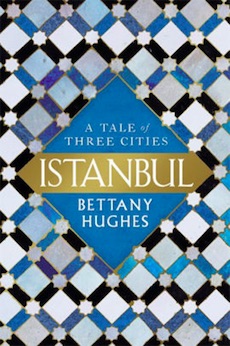By Lewis Fried
One does not read this book so much as stand in awe of it. It is a leviathan. The writing is dramatic without abandoning scholarship; it is scholarly without denying excitement. Bettany Hughes deals with the idea of Istanbul as well as its empirical presence. Drawing upon disciplines, ranging from literature to history through ecology, physical geography, cultural dynamics, and many more, she presents us with one of the broadest and among the most interesting interpretations of this fabled city. This book has many reader’s guides such as maps, illustrations, a vast chronology, and a commentary on names. The work is also leavened by her own personal observations, bringing the author to the city as well as the city to the reader. This perspective is a gift, letting us see how the city reveals itself to a bold and far-reaching intellect, as well as drawing upon the minds of others.
Nevertheless, there is so much empirical data, intellectual association, and sometimes an uneasy and unnecessary jump (or so it seems to me) from one point to another that the book’s facts, tightly packed into every paragraph, can simply overwhelm readers. (And I am one of them.) I found it easier to rely on Samuel Johnson’s advice: one can follow the narrative at one’s own pace and on one’s own path or paths. If done so, the book’s richness multiplies.
The three cities of the title, Byzantium, Constantinople, and Istanbul, designate the major strata of the metropolis’ history, but Hughes begins her work far earlier than the first city, anchoring the book in the discovery of a body, that of a Stone Age woman, unearthed by the Yenikapi train station. Although a skillful hook for the writer (and one that appears in various examples, surprising the reader, and I guess, also the writer who turns discoveries into far-reaching syntheses), Hughes illuminates how Istanbul’s past is still very much within the city’s present. And so, Istanbul becomes a concatenated narrative summoning places, pasts, and modernities pulsing across the very pavement and under the earth of the city. From the work’s beginning to its end, Hughes’ point is strongly made and well-crafted: Istanbul is both a habitation and its transcendence. And where does the one stop and the other begin? You can’t tell the dancer from the dance.
What has not been brought to Istanbul in this fascinating book—this early settlement, turned trading route, turned depository of cultures? An iteration would have to ingather the contributions of Persians, Greeks, Romans, and Ottomans, as well as the heavy influence of the French, the English, the Russians. Add to that the swirl of languages, cultures, and faiths—call it the “terroir”—of this city, demanding that a unitary narrative yield to yet other narratives that Istanbul absorbed, re-presented, and metamorphosed.
The task for the historian is enormous, and Hughes does not falter; she triumphs. In her words, Istanbul defies “categorization.” But then, how to present its density? Hughes does this by following its historical fault lines, a standard unfolding of the making of a city, but she goes far beyond this normative model. Rather, as a city connected by ideas, myths, roads, and seaway, Istanbul is process and depository. In our own day in which much angry noise is made about the clash, adjustments, and supersessionisms of faiths, races, tongues, aliens, this book presents not only the disruptive violence of these clashes but also the opportunities they created for a stunning example of city and civilization.
Whereas this work is a broad canvas, Hughes offers vignettes and dramatic portraits of events and individuals giving the city’s history a specificity, and a human face. We meet merchants, martyrs, travelers, and officials who try to adjust their lives to the colors of empires. And no less importantly, we read about invasions, plots, and counterplots resulting in the slaughter of the city’s prominent as well as small figures, with sometimes cruelly imaginative tortures. Istanbul, therefore, becomes a trope for the pressures exerted upon tangible and “spiritualized” civilizations that may not have borders but have long reaches and aftereffects.
Hughes takes Istanbul’s survival as a sign that cosmopolitanism is not an unrealistic ideal to be achieved, but a reality that is part of our own day. The city testifies to a vibrancy that cannot be ignored. As she puts it, Istanbul encourages and nourishes the “vital, hopeful notion that, wherever and whoever we end up…we share one human heart—[and] to know Istanbul is to know what it is to be cosmopolitan—this is a city that reminds us that we are, indeed, citizens of the world.” Is this an unjustifiable hope, given the lessening influence of Kemalist culture and the growing fundamentalist impact on the city (and Turkey itself)? Or is it a recognition that the present regime, like those before it, is not particularly a sport, but that the city’s manifold energies will incorporate its contributions? Let us hope so.
Lewis Fried (ΦBK, Queen’s College, CUNY, 1964) is Professor of English Emeritus at Kent State University and a resident member of the Nu of Ohio Chapter of Phi Beta Kappa.




